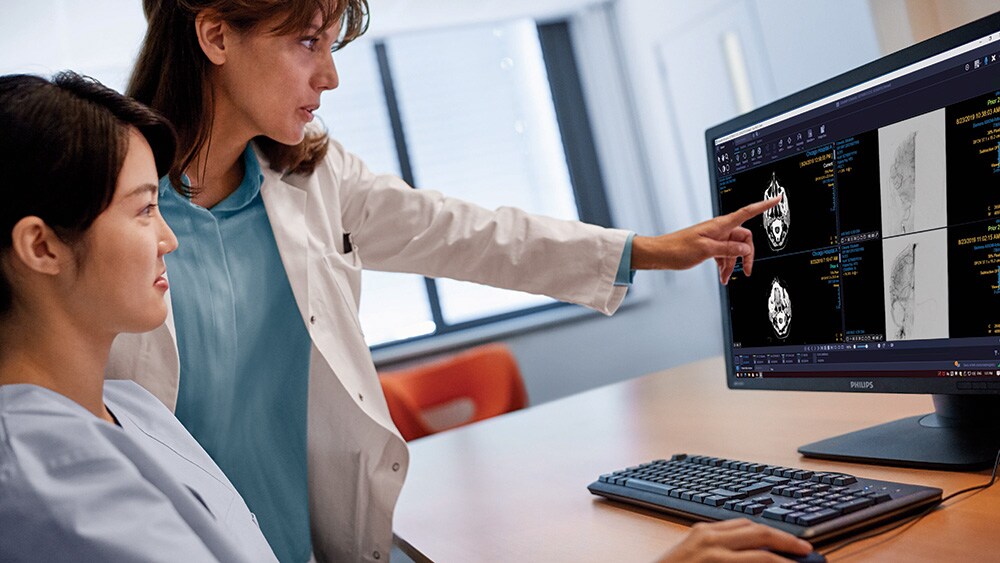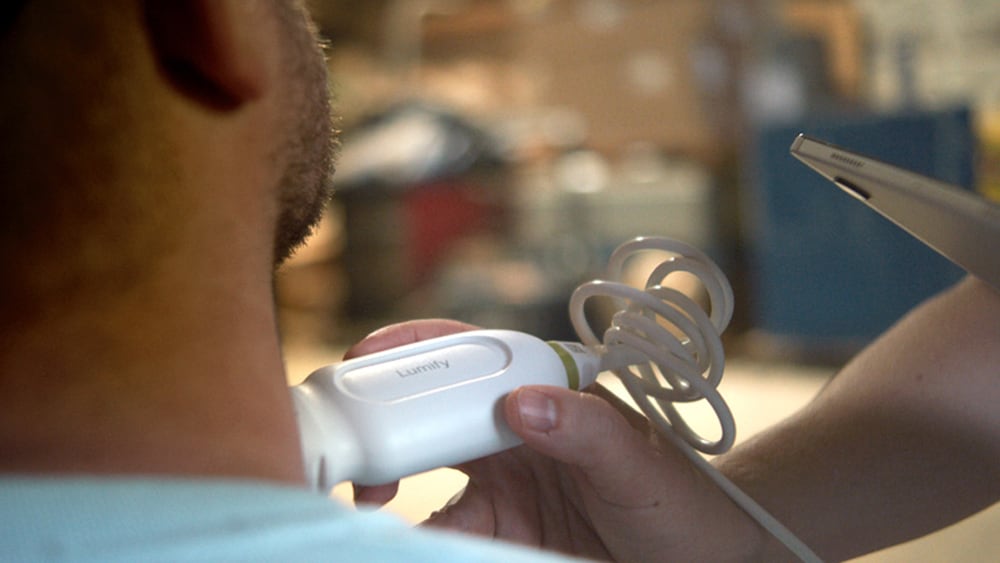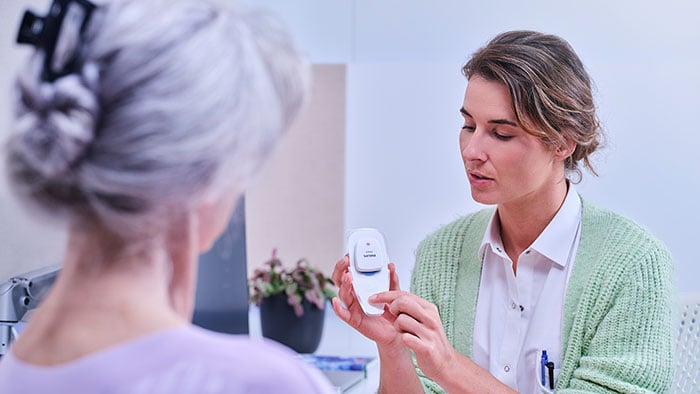10 healthcare technology trends for 2024
Nov 14, 2023 | 13 minute read
Workforce shortages in healthcare have hit crisis levels in recent years and are expected to continue into 2024, forcing healthcare organizations to do more with less as their financial situation has also come under severe pressure. Meanwhile, healthcare leaders recognize the need to address growing health disparities and environmental challenges to keep health systems sustainable and accessible for everyone. These 10 healthcare technology trends show how innovations in AI, virtual care, and other areas can make a difference by serving healthcare professionals, patients, and society at large.

1. AI-powered workflow automation and optimization
As healthcare organizations are faced with persistent staff shortages, they are adapting their workforce strategies to attract and retain talent – offering more flexibility to healthcare professionals seeking a better work-life balance. Increasingly, they are also turning to automation and AI as a way of accelerating routine tasks and measurements to alleviate the burden on healthcare professionals. In diagnostic imaging, for example, integration of AI into CT systems can automate radiographers’ most time-consuming steps so that they can spend more time focusing on the patient. AI-based reconstruction is then used to deliver the high image quality that radiologists need to make a precise diagnosis. AI can also take the complexity out of cardiac ultrasound through full 3D quantification and modeling of the heart and other automated measurements. This helps sonographers acquire and analyze images the right way, while enabling clinicians to provide better and more efficient cardiac care. In the next few years, automation will get a further boost from the rise of generative AI in healthcare. A recent survey by Bain & Company showed that healthcare leaders see the biggest short-term opportunities of generative AI in reducing administrative burden on staff and enhancing operational efficiencies [1]. Some of the most promising applications include automated documentation and summarization of patient visits – all freeing up time for physicians to focus on higher-value tasks.

2. Virtual collaboration addressing staff and expertise shortages
A healthcare technology trend that goes hand in hand with automation is the use of virtual collaboration to mitigate the impact of staff and expertise shortages. Expected growth in this area has the added benefit of improving access to care in remote and rural areas, where specialist staff tends to be in particularly short supply. Continued adoption of radiology operations command centers is a prime example. This cloud-based hub-and-spoke model enables virtual over-the-shoulder support from expert imaging technologists to their less experienced or specialized colleagues at remote sites, while the patient is on the scanner table. Similarly, real-time virtual collaboration in ultrasound can extend the reach of specialist care – allowing physicians to remotely communicate with their team and with patients whether they are in a hospital, clinic or remote satellite office. In both cases, virtual collaboration can help make expertise more widely available to achieve the same standard of care throughout a health system. Tele-intensive (or tele-ICU) programs will also continue to gain traction, with healthcare providers increasingly looking for a seamless integration of virtual care to enhance bedside care. Remote intensivists and nurses – assisted by AI-powered monitoring technology – can reduce the burden on on-site staff, complementing rather than replacing them. As the healthcare workforce continues to age, such virtual collaboration models are creating new career paths for older and experienced healthcare professionals. They can mentor and guide their younger peers remotely, preserving valuable knowledge and expertise that may otherwise get lost as more doctors are choosing to retire early and more nurses say they plan to leave healthcare.

3. Integrated diagnostics supporting multi-disciplinary collaboration
With the explosion of diagnostic data that is collected through various sources – from imaging to digital pathology and genomics – bringing all this data together in a meaningful way has become essential for physicians to deliver a precise diagnosis and treatment plan that is tailored to the patient. Yet today, this data is often scattered across disparate systems. Advancements in integrated diagnostics will enable different healthcare specialists to exchange patient data more easily, helping them work together more efficiently and effectively. Think of it as creating a shared ‘cockpit’ that brings together relevant data from different domains – in a vendor-agnostic digital environment – to support a timely and accurate diagnosis for the patient. For cancer patients, for example, that means their cancer can be diagnosed and treated more precisely at an early stage when they have better chances of favorable treatment outcomes. Different specialists also get more insight into how consistent their findings are with each other, which creates a continuous feedback loop that can help to further optimize diagnostic processes.

4. Improved interoperability for better monitoring and care coordination
Interoperability has been a perennial challenge in healthcare, stemming from the complex and fragmented nature of most healthcare IT and data infrastructures. Healthcare leaders in the Philips Future Health Index 2023 report identified it as one of the top four success factors for providing new ways of delivering care that integrate in-person and virtual care across settings. For this trend to ultimately deliver on the promise of better care coordination, healthcare technology providers will need to take an open ecosystem approach that liberates data from silos. In patient monitoring, data available from medical device vendors has historically been siloed, leaving clinicians with the laborious task of referencing multiple sources to gain a complete clinical view of the patient. The inefficiencies caused by this disjointed process can impact a clinician’s ability to deliver timely diagnoses and treatments to patients. New interoperability capabilities can bring together disparate medical devices and systems into one interface to create a comprehensive overview of a patient’s condition. This helps empower caregivers to make treatment recommendations confidently from anywhere in the hospital, alleviating the pressure caused by information overload. Recent innovations such as visual patient avatars can provide additional insights by translating critical yet complex patient data into an easy-to-understand display.

5. Early risk detection and intervention based on predictive analytics
Predictive analytics has emerged as one of the promising healthcare technology trends in recent years. By deriving operational and clinical insights from real-time and historical data, predictive analytics can help healthcare providers improve efficiencies and act preemptively. The Philips Future Health Index 2023 report showed how 39% of healthcare leaders plan to invest in AI to predict outcomes, up from 30% in 2021. Already today, predictive analytics is helping healthcare providers forecast and manage patient flow, allowing them to deploy staff and resources where they are needed the most. These capabilities have proven vital in times of crisis (such as the COVID-19 pandemic) and are now becoming a mainstay of data-driven hospital operations. Through ongoing monitoring of medical equipment such as MR scanners, predictive analytics can also help identify when certain hardware parts may need maintenance or replacement. As a result, 30% of service cases can be resolved before equipment downtime is caused – preventing avoidable disruptions to healthcare operations. Similarly, in the clinical realm, predictive analytics can support early detection of patient health risks based on vital signs and other patient data. These capabilities can be invaluable in acute care, where a patient’s life may depend on timely intervention. Predictive analytics can also help keep a caring eye on patients at home, through remote monitoring. For example, one study showed how it may be used to help predict life-threatening ventricular arrhythmias. Through early risk detection, predictive analytics can enable a shift from reactive to preventative care – ultimately resulting in better patient outcomes.

6. Using technology to tackle health disparities
Billions of people around the world still can’t access the health services they need, and even in countries with well-funded health systems, health disparities are on the rise. The need for more equitable and sustainable healthcare has never been more urgent. Pressure to address health disparities has leaders increasingly looking to healthcare technology to help bridge many of healthcare’s most pressing gaps, while at the same time reducing the industry’s environmental impact. Partnerships aimed at advancing health equity will be key to leveraging technology innovations in ways that make good on the promise digital transformation holds for improving care – especially for those in marginalized and underserved communities. Philips’ recent partnership with Emory University is one example of how technology can be used to tackle health disparities. Enabled by Philips Lumify Handheld Ultrasound and the Philips HeartStart AED, the Farm Worker Family Health Program is helping extend healthcare access to Georgia’s vital and vulnerable farmworker population. In another partnership with Heart of Australia, a mobile ‘hospital on wheels’ solution brings diagnostic imaging services, such as X-ray and CT, to hard-to-reach remote areas. And, thanks to a partnership with New York’s Roswell Park Comprehensive Cancer Center, a similar mobile solution is providing life-saving cancer screening to those who may not otherwise have access. Moving forward, healthcare technology companies will need to innovate in ways that deliver more equitable and sustainable healthcare – not just for some, but for all. And achieving this aim will require a new level of collaboration across sectors.

7. Smart technology that helps establish – and maintain – healthy routines
More than 15 years ago, wearable, customizable technology in the form of smartwatches popularized healthier physical routines, and the wide variety of increasingly sophisticated smart health devices on the market – now they’re even monitoring wearers’ vitals [1,2] – demonstrate that people continue to want health technologies that fit seamlessly into their lives, and are tailored to their evolving needs and preferences. In 2024, we expect this healthcare technology trend will continue to expand and drive healthier behaviors, for example by helping people stick to oral healthcare routines and by more closely monitoring children’s growth and development. It’s a shift to a world where people have the tools to predict and avoid potential health issues. For example, it is well documented [3] that oral health is critical to overall health. While people increasingly want to be more in control of their own well-being, there are gaps in both their knowledge and daily commitment to good oral hygiene, and they need help along the way. Electric toothbrushes that sync with AI-powered applications can collect brushing data and offer personalized recommendations to improve users’ routines. Like oral healthcare, pregnancy and parenting is an area where health technology is not a replacement for essential in-person treatment, but technologies like mobile apps can offer convenient access to actionable information, plus the simple reassurance that things are going well – because reducing stress is also part of staying healthy. For example, the Philips Pregnancy+ app is being used by the Michigan Department of Health and Human Services (MDHHS) in the US to provide expectant mothers with access to timely health education and pathways for connecting to local resources and providers.

8. Addressing healthcare IT’s environmental impact
As the above healthcare technology trends show, digitalization offers tremendous scope for more effective and efficient delivery of care. By applying clinical decision algorithms and predictive analytics, for example, we can use data to deliver personalized, actionable insights, such as alerting acute care teams to potential problems or encouraging healthy behavior through app-based coaching. Digital solutions are eminently scalable, and so support broader prevention, improved triaging, and lower cost of care, enabling a shift from resource-intensive clinical settings to lower-cost settings and the home. And for the 3.5 billion people around the world who currently do not have access to healthcare, digital healthcare technology can expand access to much-needed sustainable models of healthcare. Yet, all this ‘digital goodness’ comes at a price. No less than 30% of global data is generated by healthcare [4]. And, at 36%, the projected growth of healthcare data over the period 2018-2025 is faster than any other data type [5]. The upside is that research [6] indicates that the resource savings unlocked by IT outweigh the increase in footprint caused by the deployment of that technology – for example, shifting to the cloud. But to continue realizing these savings, the healthcare industry needs to focus on building sustainable digital infrastructure, including carbon-free cloud solutions, using circular hardware, and developing sustainable software. Encouragingly, we see a growing trend – continuing in 2024 and beyond – of health technology companies, healthcare systems, suppliers and other stakeholders teaming up to ensure we do make the right decisions to reduce healthcare IT’s environmental impact for a sustainable future.

9. Green procurement transforming the healthcare supply landscape
Responding to the pressing need to decarbonize healthcare, we are seeing a clear trend of health technology companies, healthcare systems and other stakeholders driving sustainable ways of working across every part of the healthcare value chain – including operations, innovation, service and delivery. One of the most impactful sustainability transformations is happening in the area of procurement. Fueled in part by the significant expansion of ESG disclosure requirements around the world, green procurement will increasingly shift the healthcare supply landscape over the coming years. We expect to see more purchasing departments adopting priority evaluation criteria, such as those developed by Philips, when procuring medical equipment and health technology solutions: Looking forward, the adoption of sustainable procurement criteria like these will be necessary strategies for health systems and governments hoping to mitigate climate change and biodiversity loss while safeguarding human health and advancing health equity.

10. Teaming up to reduce healthcare’s impact on the planet
Healthcare systems are part of a wider value chain – extending from extractive industries upstream to operations, logistics, use phase and end-of-use phase downstream – which has an impact on biodiversity through land use conversion, pollution, consumption and emissions. With the widespread recognition of the effect environmental health has on human health, we see a continuing trend of healthcare systems actively adopting strategies to reduce their environmental footprint. For instance: switching to resource-efficient healthcare technology and smart digital solutions, or adopting science-based targets for emission reduction – the latter mandatory for all $1 billion-plus companies in California by 2025. Yet broader nature risks may be overlooked as organizations see higher financial impacts from climate risks than from, say, deforestation or water withdrawal. The latter has direct consequences for population health. Thus, we expect to see an increasing trend towards the adoption of ‘natural capital accounting’ to support better decision-making around resource use management, and more companies committing to science-based targets for nature. At Philips, we have developed a program to improve the ecological value of our manufacturing footprint. In February 2022, Morgan Stanley reported, “The growing water crisis will no doubt require virtually all industries to rethink their water use.” Philips is not a water-intense company. However, with a number of our manufacturing sites located in water-stressed regions, we have also initiated a program to reduce our total water consumption by 5% from its 2019 level. On the planetary scale, an individual organization’s biodiversity footprint may not be huge. But unlike emissions, where individual reductions have a direct impact, ecosystem regeneration is more effective if spatially fragmented initiatives are integrated. Especially in this area, collaboration across the value chain is vital.

Sources [1] Bain & Company. Getting the most out of generative AI in healthcare. https://www.bain.com/insights/getting-the-most-out-of-generative-ai-in-healthcare/ [2] Soon S, Svavarsdottir H, Downey C, et al. Wearable devices for remote vital signs monitoring in the outpatient setting: an overview of the field. BMJ Innovations. 2020. [3] Keslar, Linda. How Your Smartwatch Could Help Unlock Secrets of Disease. WebMD. 2023. [4] World Health Organization. World Health Assembly Resolution paves the way for better oral health care. 2021. [5] RBC Capital Markets. The healthcare data explosion [6] Health Care Without Harm (2019). Health care’s climate footprint: How the health sector contributes to the global climate crisis and opportunities for action (p.22). https://noharm-global.org/documents/health-care-climate-footprint-report







